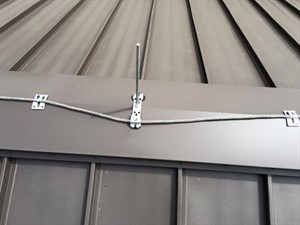Lightning Protection

- Facility Protection
The consequences of an unexpected lightning strike or power surge can be catastrophic for a facility:
-
- Personnel are at risk.
- Critical equipment may be damaged or destroyed.
- Data can be corrupted.
- The costs of operational downtime and lost revenue can be very substantial.
As industries become more dependent on increasingly sensitive equipment, proper protection from lightning and dangerous overvoltage transients is necessary.
Plan of Protection is designed to provide total facility protection by integrating several concepts. The Protection Plan will minimize the risk of damage to facilities through:
-
- Direct Strike Protection
- Grounding and Bonding
- Surge and Over-voltage Transient Protection
- Protection Plan:
- Capture the lightning strike. Capture the lightning strike to a known and preferred attachment point using a purpose-designed air terminal system.
- Convey this energy to ground. Conduct the energy to the ground via a purpose-designed downconductor.
- Dissipate energy into the grounding system. Dissipate energy into a low impedance grounding system.
- Bond all ground points together. Bond all ground points to eliminate ground loops and create an equipotential plane.
- Protect incoming AC power feeders. Protect equipment from surges and transients on incoming power lines to prevent equipment damage and costly operational downtime.
- Protect low voltage data/telecommunications circuits. Protect equipment from surges and transients on incoming telecommunications and signal lines to prevent equipment damage and costly operational downtime.
- Lightning Protection System components
- Dynasphere
The primary function of the air terminal is to capture the lightning strike to a preferred point, so that the discharge current can be directed via the down- conductor(s) to the grounding system. The Dynasphere air terminal provides optimal lightning capture.
-
- Insulated mast
- Metallic lower mast
- Down conductor
As an integral part of the System, multi-layered, low impedance, insulated downconductor conveys the lightning discharge current to ground with minimal danger of sideflashing. A unique semi-conductive outer sheath allows electrostatic bonding of the building through cable securing saddles The downconductors have been designed to meet criteria for an effective and reliable protection, with the following key characteristics:
-
-
-
- low inductance per unit length
- low surge impedance
- carefully controlled internal electric field distribution to minimize field stresses under current impulse conditions
- carefully designed, stress reducing upper termination
-
- Lightning even counter
- Inspection pit
- Low impedance grounding system
-
The grounding system must have a low impedance to disperse the energy of the lightning strike. Because the lightning discharge consists of high frequency components, we are particularly concerned with the frequency-dependent electrical parameter of a grounding system – impedance – as well as low resistance grounding. The grounding grid should minimize the ground voltage potential rise and minimize the risk of injury to personnel or damage to equipment.
○ Exothermically Welded Connections




